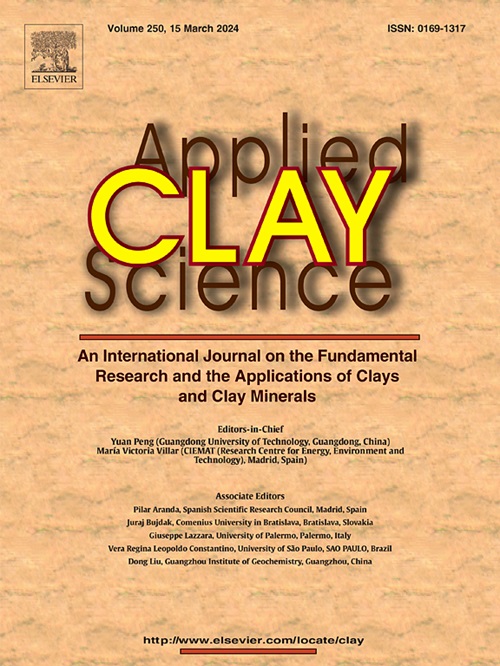Protoporphyrin-grafted halloysite nanotubes for boosted photodynamic activity in chitosan nanocomposite films
IF 5.8
2区 地球科学
Q2 CHEMISTRY, PHYSICAL
引用次数: 0
Abstract
Chitosan-based materials are widely explored for biomedical applications due to their biocompatibility, biodegradability, and excellent film-forming ability. In this work, we report the development of hybrid chitosan films reinforced with halloysite nanotubes (Hal) covalently functionalized with protoporphyrin IX (PPIX), aiming to enhance their photodynamic properties. Photodynamic therapy (PDT) has emerged as a promising and minimally invasive technique for cancer treatment due to its selectivity and low toxicity. However, the clinical use of many photosensitizers, such as PPIX, is limited by their poor solubility in water. The covalent anchoring of PPIX onto the external surface of Hal significantly improved its availability in water, which was further enhanced upon coordination with Zn2+ ions. The resulting Hal-PPIX nanomaterials were characterized by spectroscopic and microscopic techniques and evaluated, both chemically and biologically, for their ability to generate reactive oxygen species (ROS) under visible light irradiation. As proof of concept, the nanomaterials were incorporated into chitosan films and studied for their mechanical properties and AFM was employed to investigate the surface morphology of them. The results demonstrate the potential of these bio-based nanocomposites as promising candidates for topical photodynamic therapy, particularly in skin cancer treatment.

原卟啉接枝高岭土纳米管在壳聚糖纳米复合膜中增强光动力活性
壳聚糖基材料具有良好的生物相容性、生物降解性和成膜性,在生物医学领域有着广泛的应用前景。在这项工作中,我们报道了以原卟啉IX (PPIX)共价功能化的高岭土纳米管(Hal)增强的杂化壳聚糖膜的开发,旨在提高其光动力学性能。光动力疗法(PDT)因其选择性和低毒性而成为一种有前途的微创癌症治疗技术。然而,许多光敏剂的临床应用,如PPIX,由于其在水中的溶解度差而受到限制。PPIX在Hal外表面的共价锚定显著提高了其在水中的有效性,与Zn2+离子配位后,PPIX在水中的有效性进一步增强。所得到的Hal-PPIX纳米材料通过光谱学和显微技术进行了表征,并在化学和生物学上对其在可见光照射下产生活性氧(ROS)的能力进行了评估。为了验证这一概念,我们将纳米材料掺入壳聚糖薄膜中,研究了它们的力学性能,并利用原子力显微镜研究了它们的表面形貌。结果表明,这些生物基纳米复合材料有潜力作为局部光动力治疗的有希望的候选者,特别是在皮肤癌治疗中。
本文章由计算机程序翻译,如有差异,请以英文原文为准。
求助全文
约1分钟内获得全文
求助全文
来源期刊

Applied Clay Science
地学-矿物学
CiteScore
10.30
自引率
10.70%
发文量
289
审稿时长
39 days
期刊介绍:
Applied Clay Science aims to be an international journal attracting high quality scientific papers on clays and clay minerals, including research papers, reviews, and technical notes. The journal covers typical subjects of Fundamental and Applied Clay Science such as:
• Synthesis and purification
• Structural, crystallographic and mineralogical properties of clays and clay minerals
• Thermal properties of clays and clay minerals
• Physico-chemical properties including i) surface and interface properties; ii) thermodynamic properties; iii) mechanical properties
• Interaction with water, with polar and apolar molecules
• Colloidal properties and rheology
• Adsorption, Intercalation, Ionic exchange
• Genesis and deposits of clay minerals
• Geology and geochemistry of clays
• Modification of clays and clay minerals properties by thermal and physical treatments
• Modification by chemical treatments with organic and inorganic molecules(organoclays, pillared clays)
• Modification by biological microorganisms. etc...
 求助内容:
求助内容: 应助结果提醒方式:
应助结果提醒方式:


